Advertising platforms like Google Ads and TikTok ads are crucial for businesses seeking new customers.
Google Ads has a cost-effective way to reach a massive audience worldwide through its Display Network, making it a popular platform for targeting potential shoppers. Meanwhile, TikTok Ads bring a fresh approach to the somewhat stale social media landscape, especially appealing to younger audiences with engaging content.
Both platforms provide unique opportunities to expand your reach and connect with new customers.
But which one’s better? This “Google Ads vs TikTok Ads” contest will help you know which platform is best to set your campaign ads on.
This article is a segment of a more extensive piece about Google Ads vs Social Media Ads.
- What is Google Ads?
- Google Ads Pros and Cons
- What are TikTok Ads?
- TikTok Ads Pros and Cons
- Ease of Use
- Cost Efficiency and Budgeting
- Target Audience
- Ad Formats and Creativity
- Branding and Marketing Strategies
- User Engagement and Interaction
- Conversion Rates
- Analytics and Performance Tracking
- Ad Policies and Content Restrictions
- Google Ads with Social Media Ads: Comparison Other Platform
- Google Ads vs TikTok Ads – The Verdict
What is Google Ads?
Google Ads is a pay-per-click (PPC) advertising platform that allows you to display ads across Google’s network. Its strength lies in its immense reach and flexibility, making it a highly effective tool for driving traffic to a business. With over 8.5 billion searches on Google every day, the potential for visibility and customer engagement is significant.
The platform offers various campaign types, each tailored to meet different advertising goals. Google Ads’ versatility suits all-sized businesses that want to increase website traffic, generate more inquiries, or boost in-store visits.
Over time, it also provides valuable insights to optimize campaigns for better reach and effectiveness.
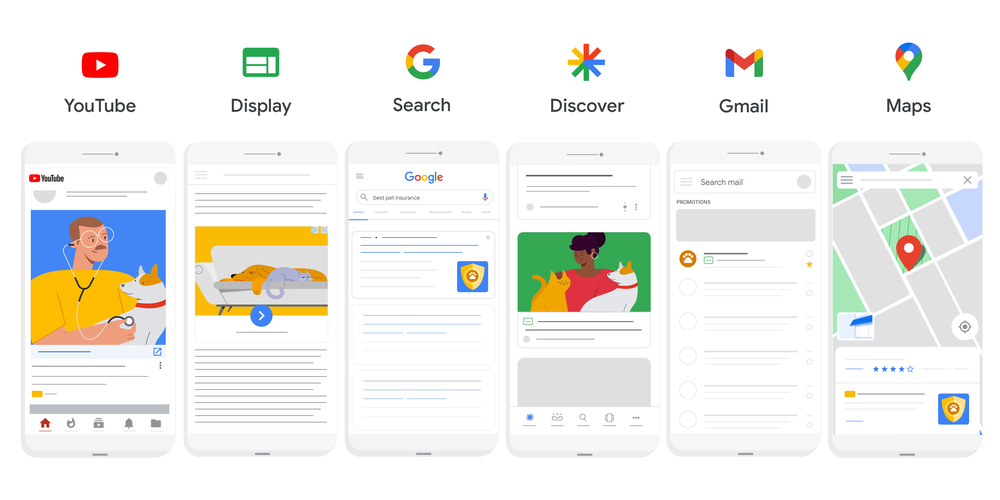
Google Ads Pros and Cons
We’ve created a list of Google Ads’ pros and cons to assist you in making informed decisions about your digital advertising strategies.
With this, you can better determine how Google Ads aligns with your marketing objectives and budget constraints.
| Pros | Cons |
|---|---|
| Ability to test and experiment to measure your ads’ effectiveness. | High costs due to highly competitive keywords. |
| Instant results, unlike other platforms like social media. | A vast array of settings and features that might be overwhelming for beginners. |
| Highly targeted advertising with options like keywords, locations, age, and search behavior. | Regular monitoring requirements and constant campaign adjustments. |
| Control over budget by setting daily budgets and adjusting bids for each campaign. | |
| Multiple Ad Formats. | |
| High reach with over 8.5 billion searches made every day. |
What are TikTok Ads?
TikTok ads is another advertising platform on the rapidly growing social media app TikTok, which has over 1 billion monthly users. It began as a video-sharing network where users posted clips of themselves lip-synching and dancing but has since evolved into a diverse platform for creative brand content.
This popular social media platform helps you to reach a vast audience through various ad formats appearing when users scroll on the “For You” feed. The app offers attractive, intuitive, and vivid ads that are shoppable, entertaining, and effective for branding solutions.
Setting up a TikTok ad is straightforward, with options for simplified and custom ad creation, catering to various marketing needs and objectives.
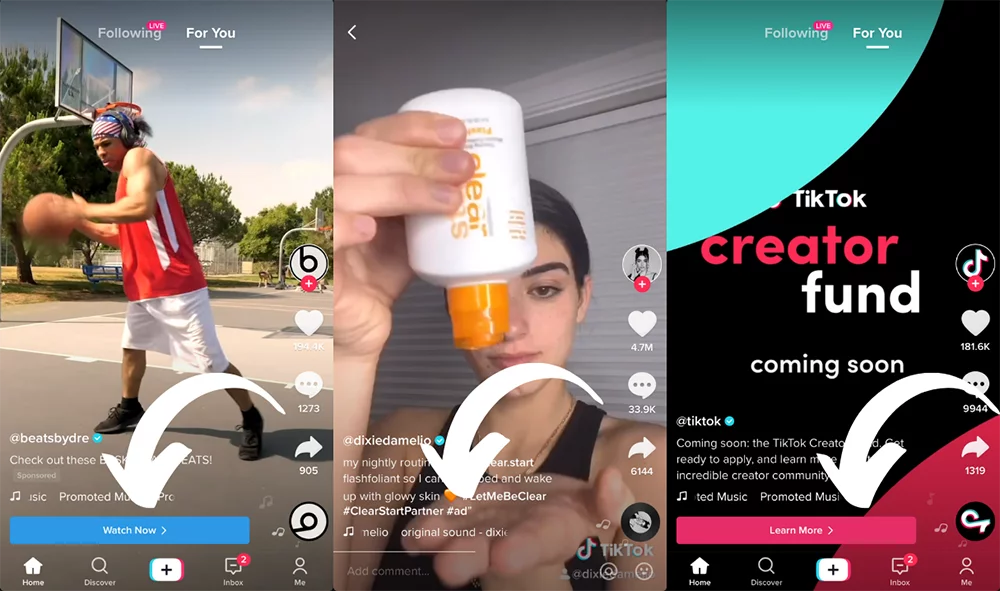
TikTok Ads Pros and Cons
Below, you will find a list of TikTok Ads pros and cons to guide your business in navigating this dynamic platform.
| Pros | Cons |
| Global audience with over 1 billion monthly users. | High costs that prevent small brands from publishing their ads. |
| Precise targeting based on audience, location, interest, and device. | Video-First platform, which may increase production costs and limit ad formats. |
| Creative engagement features like video duets, famous songs, and Stitch. | Limited audience demographics. |
| Trackable ad performance, providing detailed metrics. | |
| In-app shopping experiences enhancing direct sales. |
Ease of Use
Google Ads is known for its complexity. It requires a deeper understanding of digital marketing concepts and involves a multi-step campaign setup, including keyword research and bid management.
The platform offers many tools and resources, but mastering them demands significant time and effort. Google ads are ideal for businesses seeking detailed control over their advertising, targeting a broad audience based on search intent.
In contrast, TikTok Advertising is more user-friendly and accessible, especially for beginners. The platform focuses on creative content creation, offering a simplified campaign setup process. It’s less technical, making it suitable for small businesses or individuals prioritizing creativity over analytical marketing.

Cost Efficiency and Budgeting
Google Ads and TikTok ads present distinct approaches to get the most cost-effectiveness and budgeting, each with unique advantages.
Google Ads Cost
Google Ads operates on a paid search module using the pay-per-click model. This means you pay each time a user clicks on your ads. The platform is designed to accommodate all types of businesses, allowing them to customize the advertising spend to fit their budget.
The Google Ads tool provides the flexibility to stay within a monthly budget, with options to pause or stop ad spending at any time.
The average CPM for Google Search Ads ranges from $0.50 to $4, with an average of $3.12, which is lower than TikTok ads’ average. The average CPC for Google Search Ads varies widely across industries, ranging from $0.50 to $150, with an absolute average falling between $1 and $2.
TikTok Ads Cost
TikTok Ads presents a versatile advertising campaign approach, offering multiple ad-paying methods for different marketing goals. The platform’s ad solutions include bidding options like CPC, CPM, oCPM, CPV, and various ad types such as In-Feed and Dynamic Showcase.
The cost of TikTok Ads is flexible, with the ability to adjust your budget at any campaign stage. The platform ensures that spending never exceeds the set budget, with a minimum campaign-level budget of $500 and a minimum ad group-level budget of $50.
TikTok’s average CPM starts from $10, and the average CPC is around $1, comparable to Google Ads.
Target Audience
When considering audience targeting, age groups, and demographics, Google Ads and TikTok Ads offer robust tools for advertiser’s specific ad targeting, whether you’re looking to reach a broad audience or a more niche demographic.
Google Ads Targeting Options
Thanks to its vast user base, Google Ads helps you reach many potential customers. The ad placement flexibility across the platform, including the Google Display Network and Search Demographics, allows you to create ad campaigns for different audiences.
You can precisely target your ads based on factors like age, location, interests, and search behaviors. You can set up a custom or lookalike audience to effectively reach those interested in your products.
Additionally, keywords are pivotal in targeting options for Google Ads, where you use them to connect with potential shoppers actively searching for topics.
TikTok Ads Targeting Options
TikTok’s ad demographics segmentation caters primarily to a younger audience. TikTok users are predominantly from the Gen Z and younger Millennial generations, with ages ranging from 18-35.
They offer specific ad targeting options, allowing you to segment your audience based on age, interests, device, and other demographic factors.
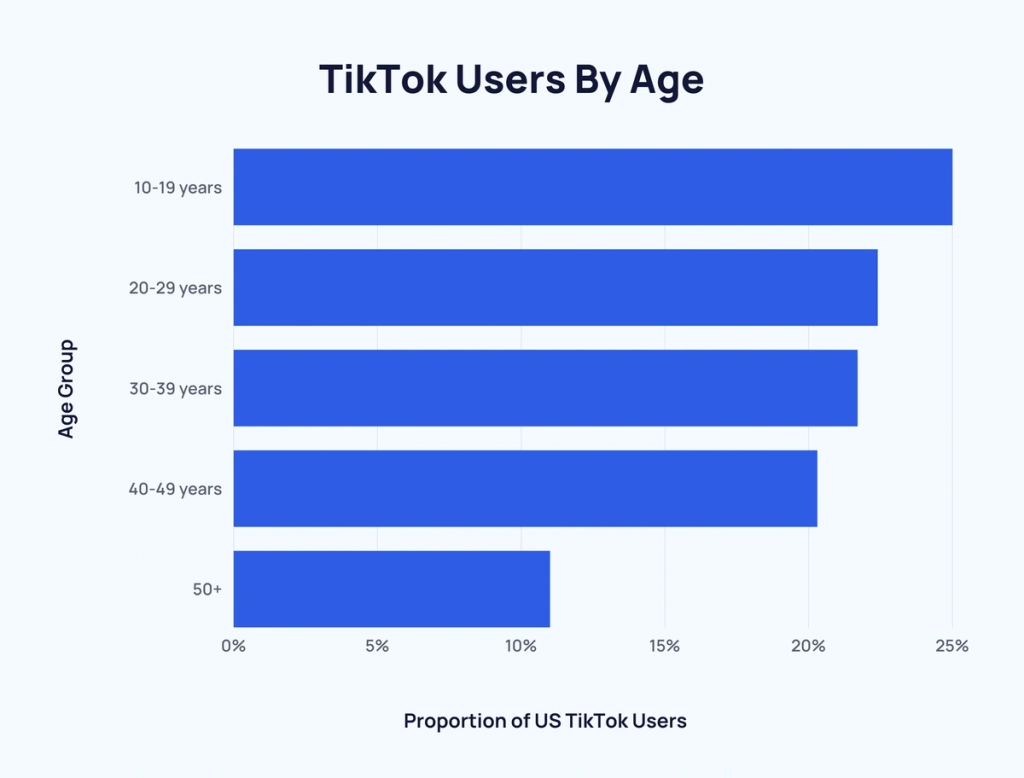
Ad Formats and Creativity
Google Ads offers multiple ad formats, each catering to different campaign goals and audience preferences.
Some of the formats you can choose for your ads are:
- Video ads: known as YouTube ads, they capture viewers’ attention through engaging visuals and storytelling.
- Shopping ads: ideal for e-commerce businesses, as they display products directly in search results.
- Link ads: a straightforward way to direct traffic to a website.
TikTok is known for its creativity and dynamic content. It offers diverse ad formats that resonate well with its user base. The platform’s primary ad format is short-form video ads, also known as In-feed ads, which align perfectly with the content typically consumed by TikTok users.
Other TikTok ad formats include:
- Carousel ads: You can showcase multiple images or videos in a single ad.
- Branded Hashtag Challenge: It encourages users to take part in your ad by submitting their videos with the ad-featured hashtag.
- Branded Effects: shareable stickers, filters, and effects you can include in your ads. You can combine it with the Branded Hashtag Challenge.
This diversity in ad formats on both Google Ads and TikTok Ads ensures you can choose the best way to convey your message and connect with your target audience.
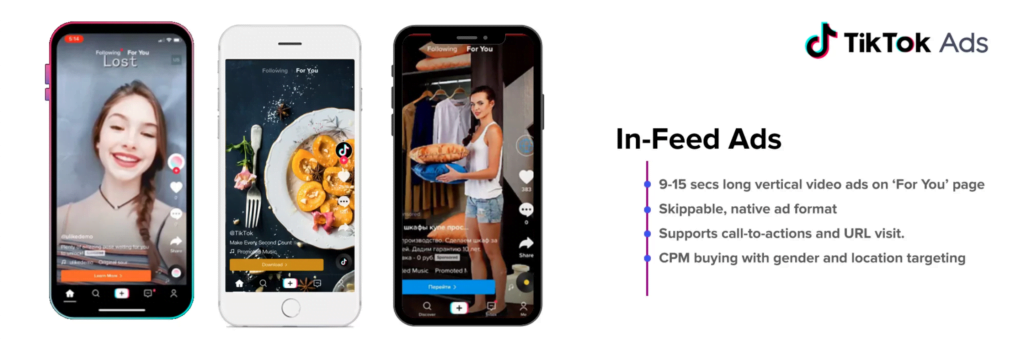
Branding and Marketing Strategies
Google Ads and TikTok Ads can be used for different branding strategies, and each one offers unique approaches to help e-commerce advertisers build brand awareness and achieve their campaign objectives.
Google Ads
This platform, mainly through its display campaigns, allows you to place ads on a vast network of websites and apps that are part of Google services. This broad reach is beneficial if you’re looking to target Google searchers who are actively seeking information and products.
Display campaigns on Google can be tailored to specific demographics, interests, and behaviors, making them a versatile tool for various marketing strategies.
TikTok Ads
TikTok ads bring a different flavor to branding and marketing. One of the standout features of its marketing is the user participation and content creation around a brand’s campaign, which amplifies brand visibility.
You can showcase your products through a personal channel, offering a fantastic platform for promotion. Likewise, this approach can quickly lead to viral content, attracting many followers in a short time.
Lastly, TikTok marketing allows you to collaborate with TikTok’s top-rated influencers or creators. Such partnerships can significantly boost engagement and increase follower count.
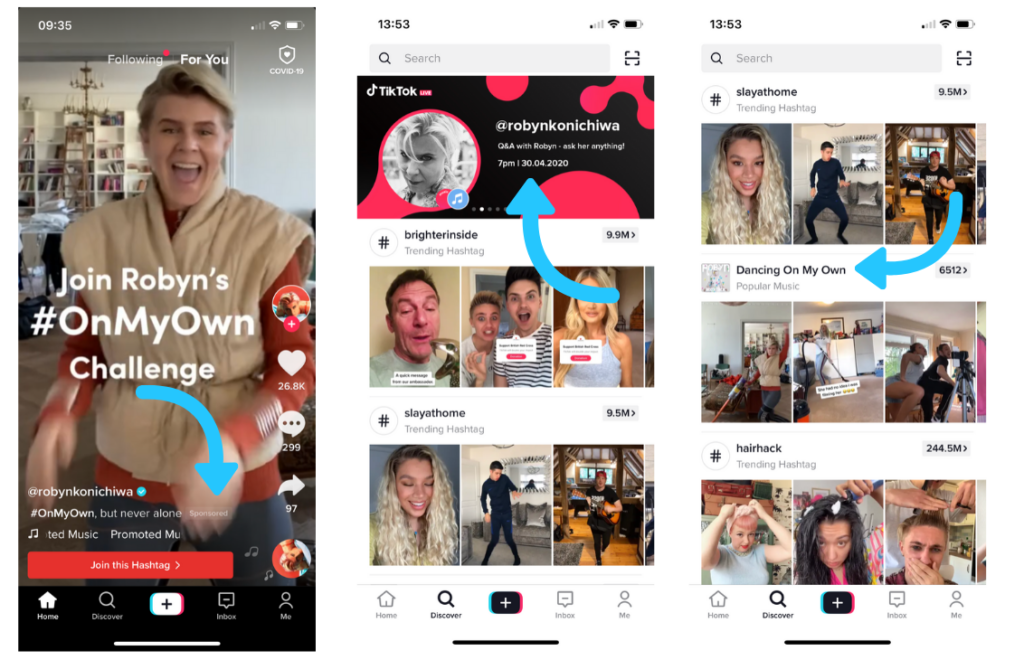
User Engagement and Interaction
Google Ads boasts an extensive reach with over 2 million websites in its Display Network and billions of users on YouTube, offering you access to a vast audience and the potential for high interaction rates through targeted ad placement.
However, the engagement rate on Google Ads tends to be lower, with about 0.57% on the Google Display Network and 4.4% on the search network.
In contrast, TikTok Ads excels in user engagement, with rates ranging from 3% to 9%, averaging around 6%. A significant 90% of TikTok users open the app multiple times a day, averaging 95 minutes of watch time daily.
In essence, while Google Ads provides a broad audience and effective targeting via search engines, TikTok stands out as the leader in engagement, rapidly building brand recognition through its highly active user base.
Conversion Rates
In digital advertising, it’s not just about getting more views on your ads. What really matters is how many of those viewers become customers.
A high conversion rate means that your ads are successfully engaging your target audience, and they are making purchases or sign-ups on your business’s website.
It’s well known that Google Ads and TikTok ads cater to different user behaviors and expectations.
Google Ads High Buying Intent
On Google, most people search for a product or service when they have a genuine need.
This high buying intent is evident when a potential customer finds a Google ad on the search engine results page that aligns perfectly with their needs. If the ad leads them to a website with appealing products and relevant features, there’s a high possibility they will convert into a customer.
Additionally, Google search ads tap into an audience with a specific purchase intent, smart targeting potential shoppers and achieving a high conversion rate.

TikTok Ads Brand Loyalty
TikTok users primarily engage with the app for entertainment rather than actively seeking the advertiser’s products. As a result, when TikTok ads appear as video content, the likelihood of users clicking on these ads to visit a website is generally lower.
While the direct conversion rate might not match search ads, TikTok offers a unique opportunity to connect with a huge audience in a more relaxed and engaging setting, contributing to long-term brand loyalty and potential future conversions.
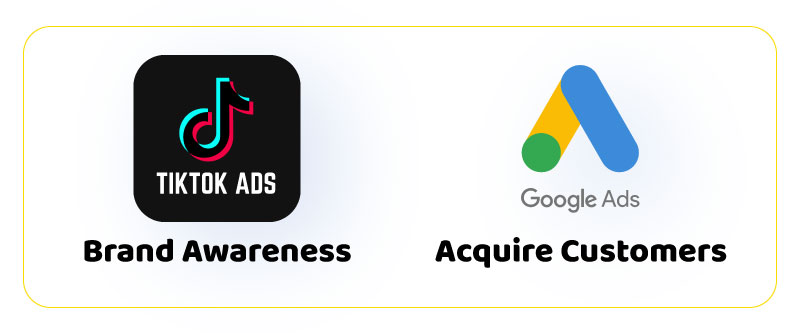
Analytics and Performance Tracking
Analytics and performance tracking plays a crucial role in campaign management, and both Google Ads and TikTok ads offer real-time data but distinctive tools and metrics. Whether adjusting bid strategies or tweaking creative elements, analyzing and acting on data is key to successful digital advertising campaigns.
Google Analytics
Google Ads provides a more comprehensive suite of analytics tools, making it one of the more distinctive Google Ads features. These tools allow advertisers to track a wide range of metrics, including:
- Click-through Rates.
- Conversion Rates.
- Cost Per Conversion.
- Return on Ad Spend.
- Impression.
- Quality Score.
This data is invaluable for refining campaign strategies, adjusting budgets, and targeting efforts.
Integrating Google Analytics with Google Ads further enhances the ability to track user behavior and campaign effectiveness, offering deep insights into how users interact with the ads and the website.

TikTok Analytics
While newer in the market, TikTok Ads also offers robust analytics and performance tracking capabilities. The platform provides detailed metrics on ad performance like:
- Cost Per Mile.
- Reach & Frequency.
- Conversion Rates.
- Cost Per View.
- Engagement Rates.
- Audience Demographics.
These insights help you understand how TikTok users interact with your ads, which can be quite different from the interactions on Google.
TikTok’s analytics will help you to tailor your content and creative strategies to resonate better with the platform’s audience, ultimately improving campaign performance.
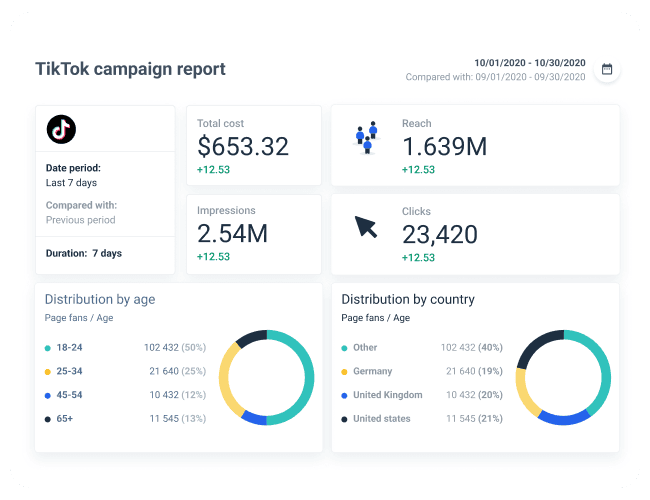
Ad Policies and Content Restrictions
Google Ads enforces strict guidelines covering various areas, including prohibited content, trademarks, and the overall user experience. These policies are designed to maintain a safe and trustworthy environment for users and advertisers.
You must ensure that your content doesn’t violate any of these rules, such as avoiding misleading information, inappropriate language, or unauthorized use of intellectual property.
Similarly, TikTok Ads also implements its own set of guidelines, focusing on prohibited content, safety, and adherence to community guidelines. They are crucial in maintaining the platform’s integrity, especially considering its younger user base.
TikTok’s policies are meant to prevent the diffusion of harmful or inappropriate content, promoting a safe online space for users.
Google Ads with Social Media Ads: Comparison Other Platform
Take a look at these informative articles to gain a deeper understanding of the differences between Google Ads and various social media platforms.
- Google Ads vs Facebook Ads,
- Google Ads vs LinkedIn Ads,
- Google Ads vs Instagram Ads,
- Google Ads vs Twitter Ads.
Google Ads vs TikTok Ads – The Verdict
Both platforms serve distinct purposes in digital advertising. Google Ads is ideal for targeting users with specific search intent on search engines, making it highly effective for immediate conversions. It excels in delivering ads to users actively seeking products or services.
TikTok ads harness the power of video marketing to engage a younger audience with more interactive and memorable content. This platform is perfect for brands that build awareness through creative and viral content.
But if you want to see results from your ads, contact our staff here at GamerSEO. We are specialists in delivering conversion results and optimizing your ad budget during all the stages.

A PPC specialist who started with organic social media. For several years, the core of his activities are:- Google Ads, Microsoft Ads, Meta Ads, TikTok Ads, Twitter Ads, Linkedin Ads. He has led campaigns with a global reach, e.g. for FootballTeam, G2A, ETOTO, as well as many smaller campaigns in the sports, construction and financial industries. Has full focus on ROAS. Privately, a fan of football, history of wars and Star Wars.

